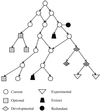Updating the Read Codes: user-interactive maintenance of a dynamic clinical vocabulary
- PMID: 9391934
- PMCID: PMC61264
- DOI: 10.1136/jamia.1997.0040465
Updating the Read Codes: user-interactive maintenance of a dynamic clinical vocabulary
Abstract
The Read Codes are a hierarchically-arranged controlled clinical vocabulary introduced in the early 1980s and now consisting of three maintained versions of differing complexity. The code sets are dynamic, and are updated quarterly in response to requests from users including clinicians in both primary and secondary care, software suppliers, and advice from a network of specialist healthcare professionals. The codes' continual evolution of content, both across and within versions, highlights tensions between different users and uses of coded clinical data. Internal processes, external interactions and new structural features implemented by the NHS Centre for Coding and Classification (NHSCCC) for user interactive maintenance of the Read Codes are described, and over 2000 items of user feedback episodes received over a 15-month period are analysed.
Figures





References
-
- WHO: International Classification of Diseases. 9th Revision. Geneva: WHO, 1975.
-
- International Statistical Classification of Diseases and Related Health Problems. 10th Revision. Geneva: WHO, 1992. - PubMed
-
- Classification of Surgical Operations and Procedures (4th revision). Office of Population Censuses and Surveys. London: HMSO, 1990.
Publication types
MeSH terms
LinkOut - more resources
Full Text Sources

